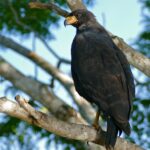The great black hawk (Buteogallus urubitinga) is a large bird of prey found in the Americas, ranging from southern Arizona and Texas in the United States to Argentina in South America. These impressive raptors are known for their diverse diet, which includes a variety of prey species, including other birds.
Prey Consumption of Great Black Hawks
Great black hawks are opportunistic predators and have been observed consuming a wide range of prey, including:
- Amphibians (frogs, toads)
- Fish
- Lizards
- Snakes
- Small mammals (including bats)
- Birds
- Crabs
- Large insects
- Carrion
- Fruits
This diverse diet allows the great black hawk to thrive in a variety of habitats, from forests and wetlands to urban areas. They employ various hunting techniques to capture their prey, such as:
- Perching and dropping down on unsuspecting prey
- Searching for prey while flying through the forest canopy
- Hunting on the ground
- Catching animals fleeing from grass fires
Do Great Black Hawks Eat Other Birds?
 Image source: Great Black Hawk by Bernard DUPONT
Image source: Great Black Hawk by Bernard DUPONT
Yes, great black hawks do consume other birds as part of their diverse diet. They have been observed preying on a variety of bird species, including:
- Smaller hawks and falcons
- Herons and egrets
- Doves and pigeons
- Songbirds
The great black hawk’s large size and powerful talons make it capable of taking down a wide range of avian prey. They may target nestlings or fledglings, as well as adult birds, depending on the availability and vulnerability of their prey.
Hunting Behavior and Adaptations
Great black hawks are well-equipped to hunt other birds. Their long legs and sharp talons allow them to grasp and subdue their prey effectively. They also have excellent eyesight and the ability to soar and scan the environment for potential targets.
When hunting birds, great black hawks may employ a few different strategies:
- Ambush Hunting: They may perch patiently and wait for an unsuspecting bird to come within striking distance, then swoop down and capture it.
- Aerial Pursuit: Great black hawks have been observed chasing and pursuing other birds in flight, using their speed and agility to overtake and capture their prey.
- Scavenging: These opportunistic predators may also feed on the remains of birds killed by other predators or accidents.
Breeding and Nesting Habits
Great black hawks are known to build platform nests made of sticks in emergent trees or on power poles. The female lays a single egg, which is incubated for 35-37 days. After the nestling hatches, the male brings food to the nest to feed the female and the growing chick.
During the breeding season, great black hawks may be more territorial and protective of their nesting sites, potentially leading to increased aggression towards other birds that venture too close.
Conservation Status and Threats
The great black hawk is currently classified as a species of Least Concern by the International Union for Conservation of Nature (IUCN). However, they may face threats in some areas, such as:
- Habitat loss and degradation
- Shooting and persecution by humans
- Disturbance at nesting sites
Maintaining healthy populations of great black hawks requires the preservation of their natural habitats, as well as reducing human-caused threats and disturbances.
In conclusion, the great black hawk is a versatile and opportunistic predator that includes other birds as part of its diverse diet. These impressive raptors employ a range of hunting strategies to capture their avian prey, showcasing their adaptations and ecological importance within their native ecosystems.
References:
- Great Black Hawk | The Peregrine Fund. (2021). Retrieved from https://peregrinefund.org/explore-raptors-species/hawks/great-black-hawk
- Common Black Hawk – All About Birds. (n.d.). Retrieved from https://www.allaboutbirds.org/guide/Common_Black_Hawk/overview
- Common Black Hawk | Audubon Field Guide. (n.d.). Retrieved from https://www.audubon.org/field-guide/bird/common-black-hawk
- ID Challenges: the Buteogallus hawks – eBird Central America. (2018, April 16). Retrieved from https://ebird.org/region/ca/post/id-challenges-the-buteogallus-hawks
- Great black hawk – Wikipedia. (n.d.). Retrieved from https://en.wikipedia.org/wiki/Great_black_hawk


